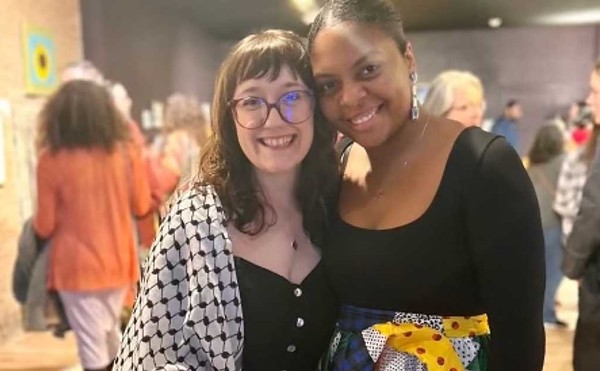On a recent Thursday afternoon, four generations of College for Creative Studies (CCS) photographers — more than a dozen current students and their teachers, as well as past students who are now teachers — meet at the Detroit Center for Contemporary Photography to eat pizza, and mine the mind of 92-year-old Detroit photographer Bill Rauhauser.
With a smile as warm as his cardigan, which is as white as his hair, Rauhauser is the last man through the door. He takes his time. The lensman is a star of sorts, but he could be some retired Midwestern grandfather. His work, however, from 1950 on, speaks volumes, with its sensitivity and storytelling. It's devilish in its contemporary coolness.
With time to spare before he takes center stage to speak, Rauhauser makes his way toward familiar faces in the room.
The DCCP's economical sampling of Rauhauser's photos show the skill and breadth of his work, as does a recently published, plainly titled collection, Bill Rauhauser: 20th Century Photography in Detroit (St. Paul's Press), which might've better been suited with a sexier name, such as Street Shots and Streamed Lines: Detroit Photography Godfather Bill Hauser Sets the Bar.
The biographical forward by writer Mary Desjarlais tells of a man who grew alongside the history of contemporary photography in Detroit, transitioning in innovation, and turning a hobby into a serious art medium. She sets the scene for several hundred of Rauhauser's mostly stunning prints.
But to see them large on the wall is a treat.
As the only gallery in the region dedicated to showing modern photography, the DCCP is a fitting location for the Rauhauser exhibit and talk. Director and chief curator Kyohei Abe — one of those CCS students-turned-teachers — founded the gallery for the same reasons Rauhauser founded the Group 4 Gallery on Indiana, south of Grand River in Detroit: to have a home for photo art where Detroit photographers can exhibit.
Soon Rauhauser is seated on a plush couch, telling his tale. He explains how a leisurely photo club spawned the Group 4, which, in 1964, was one of the first in the nation dedicated solely to exhibiting photography of art. Some students turn back to look at Abe, visualizing the connection, maybe realizing that, some day, the baton could be theirs to carry. With that baton comes a responsibility that Rauhauser hopes isn't lost on a generation raised in the digital age:
"See, there's there's photography as art, but there's also the art of taking and making a photograph," Rauhauser says. "You have exciting new technology, what with digital cameras and Photoshop and all of that, which is fine, and when you're older there will be even more advancements in technology, which is OK if you want to do that sort of thing. I'm not telling you how to make art, but the basic rules of photography will always apply, ... and what the camera shoots will always be true. The true negative never lies about what was shot; only the photographer can lie."
His advice is absolute and unsolicited. As with his photos, his aim is true.
Rauhauser is like a living legend; he's self-aware — there's lot of wisdom — but he's eternally humble as a student of his craft. He has maintained a prolific and methodical career as a photographer and educator, but you wonder if his modesty got in the way of his notoriety. That's not how he sees it.
"Ten minutes into the first class I taught and I knew that this is something I was supposed to be doing," he says.
Rauhauser is and always has been a photographer first.
When Rauhauser tells his stories, he begins with the one about trading his father's prized stamp collection to a friend at Cooley High School for an Argus Model A camera. He's told this before, and I'm sure he beams each time he first mentions French photographer Henri Cartier-Bresson, his greatest inspiration, whom he discovered in 1947.
Rauhauser himself would be "discovered" in 1951, when photographer and curator Edward Steichen, whose 291 Gallery (at 291 Fifth Ave. in Manhattan) is credited with blending photography and fine art with painting and sculpture. Steichen visited the DIA on a speaking engagement to promote photography and hype an upcoming show at the Museum of Modern Art called Family of Man. That's where Rauhauser met Steichen, who invited all photographers in attendance to submit work for the MOMA show. Out of the three Rauhauser sent along, one, "Three on a Beach," was exhibited with the work of 272 other photographers representing 68 countries.
The show traveled North America and took a years-long global journey. To be included in that show is one of Rauhauser's lifetime honors. In 1998, the DIA requested Rauhauser's work for their permanent collection, which today contains more than 343 of his black-and-white photos. "Color," Rauhauser says, "is pretty to look at, but ultimately rather distracting."
Rauhauser concludes his talk as any teacher might, with a short lecture about entering the world with vigor, integrity and, in this case, a camera that's set and ready. But first, and somewhat anticlimactically, he posits a sentiment regarding art school curriculum. Only one-third of a photographer's education, he says, should pertain to the art and science of photography, while two-thirds should be spent studying history and literature so that photographers have a sense of societal context. What he calls "the second frame."
You can see Rauhauser's background in architectural engineering in his photos. He sees naturally occurring angles and environmental irony. For instance, his photo of a man at the State Fair who's holding his face and standing in front of a painted ad featuring a another man holding his face in a very similar pose captures the synergy of components that truly compose a photo and suggest various narratives. A comprehension of chemistry brings the negative into something positively finished. It's as if the right side of Rauhauser's brain spasms in analysis, mellowed only by a purely creative exercise in street-walking snapshot anthropology. Photography is always on Rauhauser's brain. He estimates that he still shoots thousands of photos a year, one at a time.
"In the moment, when it might be there, one shot is all you need. There's no reason to snap five or six, or even two," Rauhauser says. And it's not because of his sense of economy as it pertains to the price of film. "The shot, the moment was there or it wasn't there." The success of a photograph, he believes, is the result of intuition. And his is uncanny.
As it's written in the book, Rauhauser often references Baudelaire's flâneur, an idea perhaps best characterized by the theorist Walter Benjamin: "The crowd is his element, as the air is that of birds and water of fishes. His passion and profession are to become one flesh with the crowd. For the perfect flâneur, for the passionate spectator, it is an immense job to set up house in the middle of the multitude, amid the ebb and flow of movement, in the midst of the fugitive and the infinite." Through the camera's lens, Rauhauser has documented Detroit, as well his travels to cities such as Chicago (frequently) and Seattle, as flâneur.
"Back then, before everyone had cameras and camera phones, you could be invisible, you had that power. You could be within a few feet of someone and snap a photo. Imagine that. People are highly sensitive today to the presence of a camera. It's harder to capture a genuine moment, to disappear."
But that doesn't stop him from trying. As Rauhauser heads for the door to leave, he pats the camera that slung across his chest and coat, the same way an aging detective might the gun under his jacket. "Got her right here." Rauhauser smiles. "Every single day."
As I hold the door for Rauhauser, my last question, half-kidding, is if he considers his days spent with his camera, his hobby-turned-profession, some sort of obsession.
"Obsessed?" he responds, with a strong handshake and a soft laugh. "Obsession might not be the word I'd use," his hand holds mine in pause. "The word I'd use is necessity."
Bill Rauhauser will present and sign copies of his new book at 2 p.m. Sunday, Dec. 12, at Book Beat, 26010 Greenfield Rd., Oak Park; thebookbeat.com.





